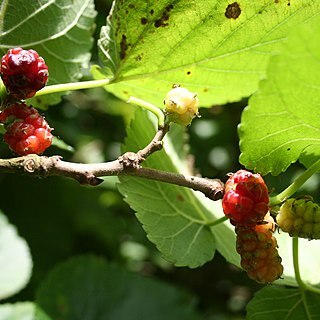Trees or shrubs, deciduous, with latex; monoecious or dioecious. Winter buds with 3-6 bud scales; scales imbricate. Stipules free, sublateral, caducous. Leaves alternate; leaf blade simple to deeply palmately lobed, margin toothed; primary veins 3-5 from base, secondary veins pinnate. Male inflorescences axillary, spicate, many-flowered, shortly pedunculate. Female inflorescences shortly spicate to capitate. Male flowers: calyx lobes 4, imbricate; stamens inflexed in bud; pistillode top-shaped. Female flowers: sessile; calyx lobes 4, imbricate, fleshy in fruit; ovary 1-loculed; style present or not; stigma 2-branched, abaxially pubescent or papillose. Fruit with enlarged, succulent calyx usually aggregated into juicy syncarp. Syncarp with achenes enclosed by enlarged and succulent calyx; endocarp shell-like; exocarp fleshy. Seed ± globose; endosperm fleshy; embryo incurved; cotyledon elliptic.
Trees or shrubs , deciduous; sap milky. Terminal buds surrounded by bud scales. Leaves alternate; stipules caducous. Leaf blade ovate to broadly ovate, margins entire or lobed, dentate; venation nearly palmate. Inflorescences pedunculate catkins, erect or pendent, cylindric. Flowers: staminate and pistillate on same or different plants. Staminate flowers: sepals 4 (4-5 in M . alba ); stamens 4, inflexed. Pistillate flowers: sepals 4, green, of 2 sizes, ciliate; ovary superior, 2-locular; style 2-branched, branches linear. Syncarps short-cylindric; each achene enclosed by its enlarged, fleshy calyx. x = 14.
Trees, dioecious; shoot-apices shed. Leaves distichous, subtriplinerved; stipules lateral, free. Inflorescences bracteate. Staminate inflorescences spicate; tepals 4, basally connate; stamens 4, inflexed in bud; pistillode present. Pistillate inflorescences capitate; tepals 4, basally connate; ovary free; stigmas 2, filiform, subequal in length. Fruiting perianth enlarged, fleshy, greenish to yellow; fruit free, somewhat drupaceous. Seed small, with endosperm; cotyledons flat, equal, plane.
Monoecious or dioecious; fls in cylindric catkins, the staminate longer and more loosely flowered than the pistillate; cal deeply 4-parted; stamens 4; style deeply 2-parted; fr a short-cylindric, edible syncarp resembling a blackberry, composed of juicy, accrescent but scarcely coherent calyces, each enclosing a small, seed-like achene, with the remains of the style protruding; trees with alternate, serrate or lobed (often mitten-shaped), palmately veined lvs. 10, widespread.
Trees or shrubs, monoecious, deciduous. Leaves serrate. Inflorescences axillary, unisexual, shortly spicate. Male flowers 4-merous; filaments inflexed in bud; small pistillode present. Female flowers with 4 imbricate perianth lobes; staminodes absent; style with 2 linear branches. Fruit a group of drupelets enclosed in the enlarged, fleshy perianths. Endocarp thin. (Green 1994: 63). See Ross (1983: 61), Harden (1990: 346–347).



